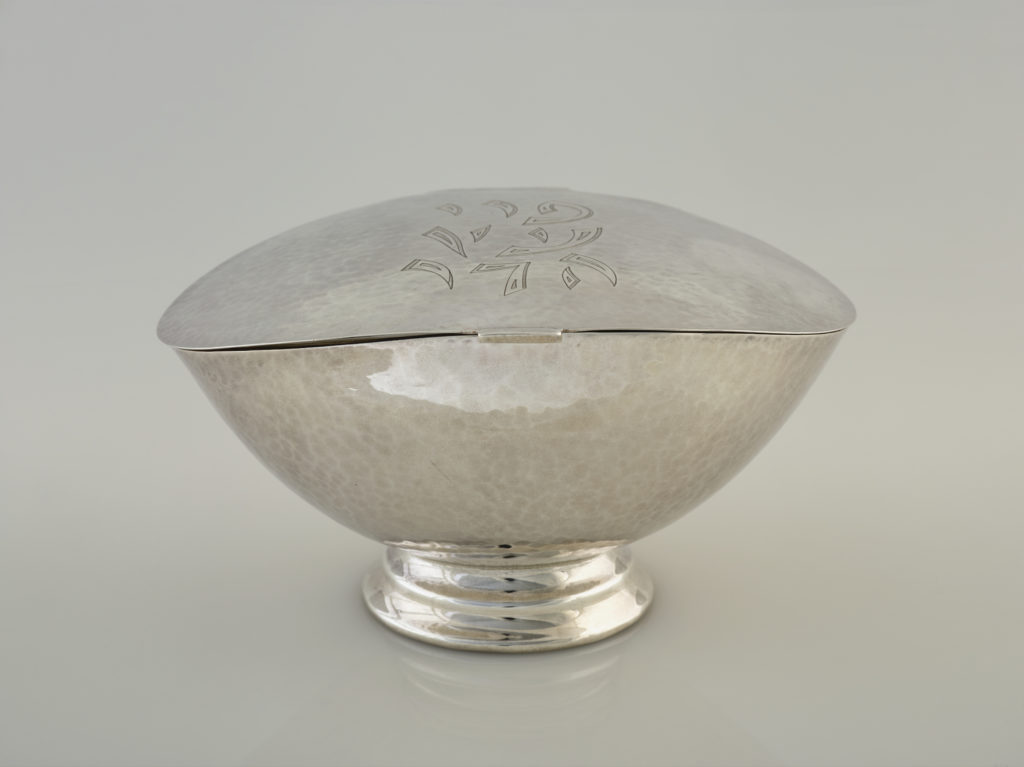Etrog Container (work of art)
Artwork Info
Key Ideas
- The artist used a special hammer and metal punches to push the metal from the back or the front of this case, to raise and lower the silver and create its unique design.
- Etrog cases protect the delicate citron, or citrus fruit, used throughout the Jewish eight-day festival of Sukkot (soo-coat).
- Ludwig Yehuda Wolpert was born in Hildesheim, where he grew up in an observant Jewish family. As a young man, he studied at the School for Arts and Crafts in Frankfurt-on-the-Main. After a few years working as a sculptor, Wolpert returned to the school and specialized in metalwork. In 1933 he immigrated to British Palestine and became well-known for his Jewish ceremonial art.
- Etrog cases are available in a wide variety of materials and designs. These include elaborate silver boxes, rectangular vinyl bags, and cases made of wood, leather, and plastic.
Learn More
Sukkot is both an ancient harvest festival and a commemoration of the 40-year wandering of the Israelites in the wilderness. The agricultural aspect of the eight-day holiday is evident in the ritual involving an etrog, which is a citron or citrus fruit, and lulav (loo-love), which are bound stems of palm, willow, and myrtle leaves. The etrog is often kept in a special protective case.
An etrog is a yellow citrus fruit that is grown mostly in parts of Italy, Greece, Israel, and a few Central and South American countries. Strongly scented and larger than a lemon, an etrog is used in addition to the lulav during the holiday of Sukkot. It is important for the etrog to be stored in a protective case since this fragile fruit cannot be used if its skin or pitom (pee-tome), which is the fruit’s attached bud, are damaged.
The earliest and most prized etrog cases were produced by skilled craftspeople in Augsburg and other cities in the German states, or principalities, during the 1600s. In the early 1700s, a common household container known as a Zuckerdose (which was used to store sugar in many German homes) was used as an etrog case for one week each year.
As part of the concept of hiddur mitzvah (finding ways to beautify or elevate Jewish rituals and religious commandments), the ideal etrog has no blemishes and the pitom (or pistil) on top is intact and undamaged. It is important to protect the etrog and ensure that it remains undamaged during Sukkot. The etroggim (plural form) that were not used during Sukkot had various other uses. The thick peel was either pickled in vinegar or boiled to a pulp and eaten, or the fragrance from the peel was extracted and used as perfume. According to the Jewish text the Talmud, the etrog was also highly valued as an antidote to poisonous snake bites.The English translation of the case’s engraved Hebrew script is ”the fruit of a goodly tree” (Leviticus 23:40). The Hebrew Bible refers to a tree described as hadar, which means “splendid” or “majestic.”
Additional Resources
Resources for Teachers:
- Read an article and watch two videos about the use of the lulav and etrog.
- Read a short article about Ludwig Yehuda Wolpert.
- Explore the techniques that were used to create and decorate this etrog case.
Resources for Students:
- Examine another etrog case from the collection of the Jewish Museum in London. Scroll through the images to see scenes on the box referring to the festivals of Sukkot, Rosh Hashanah, and Shavuot. These were the three pilgrimage holidays during the time of the ancient Temple in Jerusalem.
- Watch a video to learn how the lulav and etrog are used during Sukkot.
- Listen to a short podcast about another work by Wolpert: his innovative and modern Passover set at the Jewish Museum in New York City.
- Explore other works by Wolpert.

